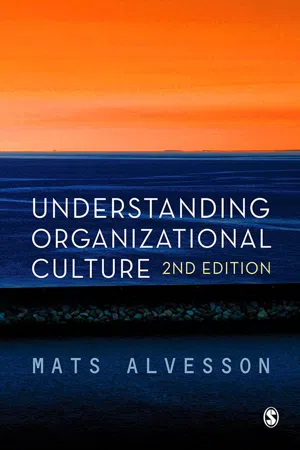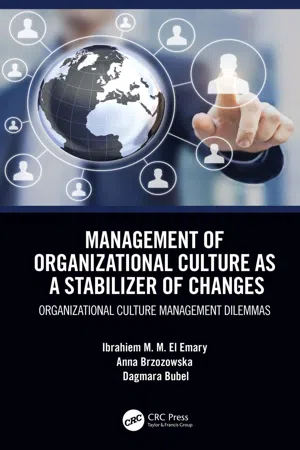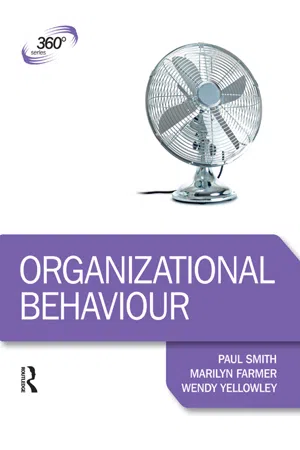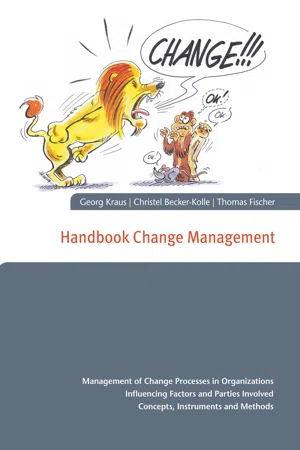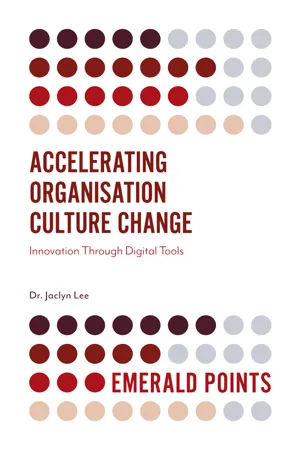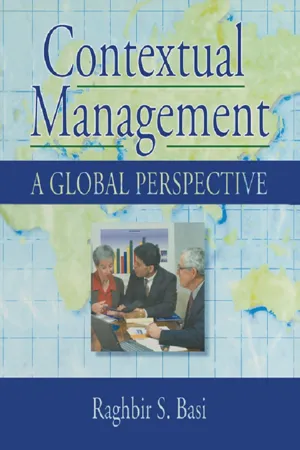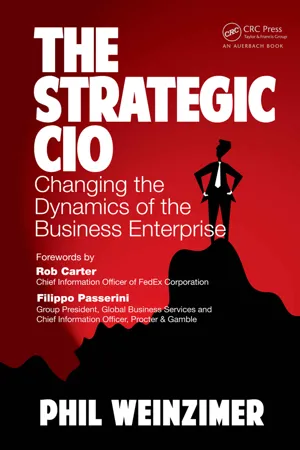Business
Organizational Culture Problems
Organizational culture problems refer to issues within a company's shared values, beliefs, and behaviors that can hinder productivity, innovation, and employee satisfaction. These problems may manifest as resistance to change, lack of diversity and inclusion, poor communication, or toxic work environments. Addressing organizational culture problems is crucial for fostering a healthy and productive workplace.
Written by Perlego with AI-assistance
Related key terms
Related key terms
1 of 4
Related key terms
1 of 3
11 Key excerpts on "Organizational Culture Problems"
- eBook - ePub
- Mats Alvesson(Author)
- 2012(Publication Date)
- SAGE Publications Ltd(Publisher)
1The Concept of Organizational Culture
Organizational culture is one of the major issues in academic research and education, in organization theory as well as in management practice. There are good reasons for this: the cultural dimension is central in all aspects of organizational life. Even in those organizations where cultural issues receive little explicit attention, how people in a company think, feel, value and act is guided by ideas, meanings and beliefs of a cultural (socially shared) nature. Whether managers think that culture is too soft or too complicated to bother about or whether there is no unique corporate culture does not reduce the significance of culture. Senior organizational members are always, in one way or another, ‘managing culture’ – underscoring what is important and what is less so and framing how the corporate world should be understood. Organizations practising intensive ‘numbers management’ may develop and reproduce a culture celebrating performance indicators and rituals around the handling of these. In most contemporary organizations, corporate culture receives a lot of attention and is seen as crucial. A key concern is that ‘culture management aspires to intervene in and regulate being, so that there is no distance between individuals’ purposes and those of the organization for which they work’ (Grey, 2005: 68).However, even in those cases where top managers have a strong awareness of the significance of culture, there is often a lack of a deeper understanding of how people and organizations function in terms of culture. High ambitions in attaining cultural control are seldom fully realized. Culture is as significant and complex as it is difficult to understand and ‘use’ in a thoughtful way. Awareness of and interest in culture vary between managers and companies. It is often difficult to attain a high level of cultural awareness to guide actions. The interest in quick fixes in much management writing and thinking is unhelpful. Instead a well-elaborated framework and a vocabulary in which core concepts – culture, meaning, symbolism – are sorted out are necessary for understanding and for qualified organizational practice by consultants, managers and others. - eBook - ePub
Management of Organizational Culture as a Stabilizer of Changes
Organizational Culture Management Dilemmas
- Ibrahiem M. M. El Emary, Anna Brzozowska, Dagmara Bubel(Authors)
- 2020(Publication Date)
- CRC Press(Publisher)
The condition for employing the methods of organizational management that are adequate to new situations is fundamental cultural change, which involves a shift from an organizational culture that promotes uncertainty avoidance to a culture that facilitates high tolerance of uncertainty. An organization can be expected to be able to cope with uncertainty and not treat it as something highly stressful or paralyzing its activities. It is claimed that cultural stereotypes can be a significant obstacle in implementing desirable changes. It is important to make sure that the shift in culture towards high tolerance of uncertainty does not result in new stereotypes established in place of the old ones, but in a critical approach to stereotypes generally. Organizational culture, even one undergoing change and transformation, should constitute a relatively stable anchor for an organization defining the area and style of its functioning (Bruhn, Meffert, and Hadwich 2019, pp. 945–1016).The processes of organizational culture formation take place through acceptance of solutions that allow the organization to better cope with difficulties. When the proposed solutions are effective, the group consciously accepts the values related to them. Perceived successes determine acceptance and assimilation of the successful elements of culture. Over time, such values are accepted as natural and gradually removed from the consciousness. They become well rooted in the subconscious of the organizational members. Thus, the elements of culture that have been confirmed by experience achieve the status of its real components. This is experience gained during group problem-solving.3.2 Diversity of Cultural Values in Organizations In the Context of Changes
The diversity of preferred social, economic and political values definitely has implications for management, in both homogeneous and heterogeneous environments. Cultural diversity, which also determines organizational culture in organizations, focuses around economic issues, such as the attitude to wealth and the approach to entrepreneurship, profit or unemployment, analyzed from the perspective of religion. Preferred social, economic and political values espoused by the followers of different religions are also very important. Therefore, it is necessary to create a concept of cultural diversity management in organizations that allows them to maximize the benefits of diversity and minimize the burdens. The idea of diversity management is, as it were, a response to the requirements of the environment, when organizations operate in a global environment. Cultural diversity is a double-edged weapon for an organization, as it can help it to gain a competitive edge, but it can also be a factor leading to numerous failures. It can be a precious resource contributing to an organization’s success, and at the same time a source of many conflicts, caused, among other things, by misunderstandings during contacts between members of differing groups. - eBook - ePub
- Paul Smith, Marilyn Farmer, Wendy Yellowley(Authors)
- 2013(Publication Date)
- Routledge(Publisher)
Reflecting on the last activity, you may have found that culture can be a unifying experience or an unsettling one, with conflicts and clashes between subcultures in an organization. A deeper perspective of culture, demonstrating the complexity surrounding the concept, is put forward by Martin (2006, cited in Matthew and Ogbonna 2009). Martin proposes the ‘three perspective framework’ of culture, which ‘simultaneously captures the unifying aspects of culture, the sub-cultural themes, as well as the contradictions in organizational life’ (Martin 2006, cited in Matthew and Ogbonna 2009: 658). The three perspectives are:• integration perspective – the shared beliefs, values and attitudes holding the organization together• differentiation perspective – the differences in the way people behave and think in an organization, particularly within subgroups, and the conflicts and clashes that can exist as people interpret prevailing norms in different ways• fragmentation perspective – portrayed as when there is ambiguity, a lack of clarity and therefore confusion as to how to behave and act within an organization. So employees will drift between subcultures and can feel left out and confused as to what the accepted norms are.To summarize organizational culture, it is a multifaceted concept, with varying levels of complexity, making culture a constant challenge for organizations to tackle. Yet we know that a major focus for change within organizations often involves cultural transformation.9.4 Change in organizations
Since the economic downturn in 2007/8 and the ‘credit crunch’, if we were to summarize what is happening within the world of business, the main aspect would be about ‘change’. Organizations have had to restructure, reduce in size, make employees redundant or merge with other companies to increase their chance of success, and change their product range and the services they offer to keep providing what their customers demand. Just watch the news every morning for one week and you will note that many companies have to adapt what they do to keep afloat. The rising cost of fuel, increasing restrictions on bank lending, increased global competition, lack of skills in the labour market, problems with the euro, and so on have all had a dramatic impact on how organizations operate. Those organizations with the ability to change and adapt quickly are more likely to be able to survive in this turbulent climate. Changes required by organizations that are driven by external forces are often not planned for, but the organization that deals effectively with such pressures is likely to survive. - eBook - ePub
Handbook Change Management
Management of Change Processes in Organizations Influencing Factors and Parties Involved Concepts, Instruments and Methods
- Georg Kraus, Christel Becker-Kolle, Thomas Fischer(Authors)
- 2017(Publication Date)
- Books on Demand(Publisher)
What is the purpose and use of organizational culture regarding organizational success? The larger the organization is, the more complex the organization is, the more roles members take on, the more difficult it will be to directly guide and lead the organization. In such confusingly complex organizations and situations, values, norms, and defined behaviors are important in order to be able to deal with uncertainty. A group that has reached a consensus about what is right or wrong is more likely to manage new challenges than a group that has not reached such a consensus.Over the past few years, the advantage of being a well-founded corporate culture during difficult economic times has been touted. At the same time, researchers warn of the “rose-coloring” in this theory. An organization can have strong internal cooperation and still struggle in the market. This is an important factor that is overlooked in many publications and discussions. If the corporate culture is connected to the external conditions, then it can be of use to management. If this link is missing, however, and the culture is only concerned with the company itself, then we can assume that the impact on business will be nonexistent or gravely neglected. The fact that employees are comfortable and live together in agreement does not necessarily result in economic success.6.3 Basics of organizational culture change
During an organizational change process, the corporate culture needs to change as well. At the same time, the question arises of whether and in what ways culture can be used to support change management.It is important to note that organizational culture changes constantly, even if it has already been printed on high gloss paper or chiseled in stone in the entry hall. The values of a culture manifest only through the successes and failures experienced collectively over time. Research suggests that a relatively strong culture emerges after 30 years and that a change in culture takes around seven years.Since culture leads to the creation of “perception glasses” through which members now see the world, a stability and resistance to shift values emerge. The sturdier the definition, the more difficult it is to change the values. If there are free spaces, tolerance and transformability, then values can be changed faster. Therefore, it is important to have enough stable values in a strong corporate culture to create reliability, yet have enough flexibility in the values to maintain guidelines during times of change. Corporate culture needs to be both stable and malleable. - eBook - ePub
Accelerating Organisation Culture Change
Innovation Through Digital Tools
- Jaclyn Lee(Author)
- 2020(Publication Date)
- Emerald Publishing Limited(Publisher)
2
Organisational Culture and Change Management2.1 Definition of Organisational Culture
Cameron and Quinn (2011) defined organisational culture as, “…the taken-for-granted values, underlying assumptions, expectations, and definitions that characterize organizations and their members. It is an enduring slow-to-change core characteristic of organisations” (Cameron & Quinn, 2011).Edgar H. Schein, a well-known culture guru, defines organisational culture as “A pattern of basic assumptions that a given group has invented, discovered, or developed in learning to cope with its problems of external adaptation and internal integration, and that have worked well enough to be considered valid. It is therefore taught to new members as the correct way to perceive, think and feel in relation to those problems” (Schein, 2004).Culture is also very complex and not easy to crystallize. However, it is a critical part of the organisational glue that binds people together toward a common vision and goal. Fralinger and Olson (2011) state that a strong and well-defined culture helps to pave the way for stakeholders to align their actions toward achieving an organisation's vision and objectives. Satya Nadella, in his book, Hit Refresh (2017), shares that an organisational culture is not something that can simply unfreeze, change, and then refreeze in an ideal way. It takes deliberate work, and it takes some specific ideas about what the culture should become.In another definition, the concept of culture, as described by a very successful CEO of a large global company with whom I recently spoke to, is one in which culture and values are very much integrated. It is the reason customers trust a company and why employees feel attracted to and have a sense of belongingness. This is also what holds a community together. He shares that culture needs to be built over time and protected, as it is something that can be fragile and easily broken. - eBook - ePub
Contextual Management
A Global Perspective
- Erdener Kaynak, Raghbir S Basi(Authors)
- 2013(Publication Date)
- Routledge(Publisher)
Chapter 4
Organizational Cultures and Management Styles
—Edgar ScheinOrganizational culture is the pattern of basic assumptions that a given group has invented, discovered, or developed in learning to cope with its problems of external adaptation and internal integration, and that have worked well enough to be considered valid, and therefore to be taught to new members as the correct way to think and feel in relation to those problems.1A culture is the accumulated set of norms, beliefs, rituals, activities, institutions, decision-making and communication patterns and traditions of an identifiable group of people. It is an ongoing proactive process of reality construction that is an active living phenomenon through which people create the worlds in which they live. Stated simply, a culture is “the way we do things around here.”ELEMENTS OF ORGANIZATIONAL CULTURES
An organizational culture may be likened to a pond which has inputs, outputs, and throughputs. The input is the fresh water coming in, the throughput is the symbiotic relationship of all life in the pond, and the output is the water spilling over into other systems. Organizations have fresh inputs of people, ideas, goals, and technology. The throughput process includes physical space, technology, rules, role relationships, interaction methods, attitudes, values, and beliefs. Outputs are products and services useful to other systems. The organizational inputs, throughputs, and outputs interact to create the culture.Dyer2 has described organizational culture as consisting of artifacts, perspectives, values, and assumptions. Through this analysis, the development of an organization’s cultural pattern can be visualized.When a newcomer encounters a foreign system, “sights and sounds” different from the old, familiar culture are immediately recognized. Technology or artifacts are the overt, tangible expressions of the underlying culture, but artifacts are just the starting point for identifying and understanding the culture of a group. To understand the meanings behind these artifacts, related behavior patterns of the organization’s members must be investigated. - eBook - ePub
The Strategic CIO
Changing the Dynamics of the Business Enterprise
- Philip Weinzimer(Author)
- 2018(Publication Date)
- Auerbach Publications(Publisher)
Organizational culture is composed of underlying characteristics that can complement and/or compete with the characteristics of other types of organizational cultures within a company. Organizational culture is the outcome of group behavior and norms, which represent the rules that govern the group behavior. Personnel turn off cell phones in meetings as a sign of courtesy to fellow attendees, respect the opinions of others during group discussions, and encourage open communication. These are all behaviors that groups of people accept as rules that govern the work environment. Sometimes, group norms can be in conflict. Encouraging creativity and innovative work habits may be acceptable in the advertising department but conflicts with the activities of the medical laboratory environment that processes blood samples. Each of these group norms is acceptable behavior, but not conducive to the specific work environment.4. Organizational culture must be measured—both current and desired state.Measuring your organization current versus desired state is important because it will identify any potential gaps that can impede your organization’s ability to perform work effectively. For example, you need to identify some alternative scenarios for developing an application enhancement for the sales organization. You ask a group of developers to meet and discuss the requirements with a group from the sales organization. Together, they together, identify a few scenarios based on risk, cost, and schedule. If the underlying behavior characteristics in your development team include a work environment that is isolated from the business and is a very structured and controlled environment, then it would be difficult for the developers to work in a collaborative environment with business teams. If you do not measure the current state as well as the desired state of your organizational culture, you will never know what roadblocks are ahead of you when implementing new strategies.These are the four concepts that we will analyze in this chapter. Understanding these four concepts will help you determine the appropriate strategic IT competencies and skills your IT teams and other business unit teams require to be successful in implementing your company business model, the topic of the next chapter. - eBook - ePub
- John Brinkman(Author)
- 2014(Publication Date)
- Routledge(Publisher)
7 Organisational Culture and Change‘There is something in all countries called management, but its meaning differs to a larger or smaller extent from one country to another, and it takes considerable historical and cultural insight into local conditions to understand its processes, philosophies and problems.’(Hofstede, 1993, p. 88)Chapter Outline7.1 Introduction7.2 What is culture?7.3 What do we understand by organisational culture?7.4 Cultural change7.5 Why we need change7.6 Managing change7.7 SummaryChapter Objectives After carefully reading and engaging with the tasks and activities outlined in this chapter, you should have a better understanding of:•what society understands by culture•some of the various classifications that help with our understanding of different aspects of culture•cultural differences that make organisations unique•differences between the managerial perspective and the social science viewpoint of cultural change•reasons why organisations experience change and the difficulties associated with implementing change•how to apply Lewin’s and Kotter’s techniques to assist in the change process.7.1 IntroductionYou have probably studied with a number of different tutors who have set different standards of expectation, both in class and for assignments. In so doing you have probably experienced a different culture in one tutor’s class compared to another: one tutor may have fostered a relaxed casual atmosphere, another may have been more formal. To be successful as a student, you have generally to adapt to the atmosphere of the class.Key TermsCulture is the set of key values, beliefs and understandings shared by a group of people.The same situation arises in organisations with employees who join the organisation adapting to the organisational culture. Culture, however, is difficult to classify and can be studied at a number of levels. It can also be very different in the various parts of an organisation. For example, most organisations would have a different culture in their marketing department compared to the culture of the finance department. - eBook - ePub
Introduction to Human Resource Management
A Guide to HR in Practice
- Charles Leatherbarrow, Janet Fletcher(Authors)
- 2018(Publication Date)
- CIPD - Kogan Page(Publisher)
These seven characteristics: innovation and risk taking, attention to detail, outcome orientation, people orientation, team orientation, aggressiveness and stability, when taken together, define how employees perceive the organisation. Each characteristic may be more or less dominant in different organisations, so defining the perceived prevailing culture. Lorsch and Tierney (2002) suggest that the true nature of an organisation’s culture is what its members do when they are not being observed. Why study organisational culture? By studying an organisation’s culture, it enables HR practitioners, managers and consultants to understand why people in organisations behave as they do. Attempts can then be made to change an overtly negative culture to make it more conducive to the achievement of section, department and overall organisational objectives. Moorhead and Griffin (1992) consider that organisational culture probably exerts the greatest influence on individual behaviour when the culture is taken for granted. One of the major reasons that organisational culture is such a powerful influence on employees is that it is not explicit. Instead, it is an implicit { meaning it is not plainly expressed } part of the employees’ values and beliefs. According to Greenberg (2013, p370): ‘It would be reasonable to think of organisations as unique because of the various cultural forces that shaped them. Indeed, culture plays several important roles in organisations.’ Greenberg (ibid) suggests that culture: provides a sense of identity; generates commitment to an organisation; clarifies and reinforces standards of behaviour. Zhang and Iles (2017, cited in Rees and Smith, 2017) point out the difficulties of offering a silver-bullet approach { meaning – the best/most appropriate method } by suggesting the type of culture that should be adopted to best deliver corporate goals - eBook - ePub
Corporate Assessment (Routledge Revivals)
Auditing a Company's Personality
- Adrian Furnham, Barrie Gunter(Authors)
- 2015(Publication Date)
- Routledge(Publisher)
These levels are arranged according to their visibility, such that behaviour and artefacts are the easiest to observe, while the underlying assumptions need to be inferred. While behaviour and artefacts may be observable and beliefs and values can be articulated, their meaning may not be readily comprehensible. To understand what the behaviour or beliefs actually mean to the participants/employees, the underlying assumptions have to be brought to the surface or made manifest, which is most difficult as this level of culture is considered to be taken for granted and thus beyond awareness.More recently Schein (1990) has noted:For our purposes it is enough to specify that any definable group with a shared history can have a culture and that within an organization there can therefore be many subcultures. If the organization as a whole has had shared experiences, there will also be a total organizational culture. Within any given unit, the tendency for integration and consistency will be assumed to be present, but it is perfectly possible for coexisting units of a larger system to have cultures that are independent and even in conflict with each other.Culture can be defined as: (a) a pattern of basic assumptions; (b) invented, discovered, or developed by a given group; (c) as it learns to cope with its problems of external adaptation and internal integration; (d) that has worked well enough to be considered valid and, therefore; (e) is to be taught to new members as the; (f) correct way to perceive, think, and feel in relation to those problems.The strength and degree of internal consistency of a culture are, therefore, a function of the stability of the group, the length of time the group has existed, the intensity of the group’s experiences of learning, the mechanisms by which the learning has taken place (i.e.: positive reinforcement or avoidance conditioning), and the strength and clarity of the assumptions held by the founders and leaders of the group.(p. 11 - eBook - ePub
A Handbook of Work and Organizational Psychology
Volume 4: Organizational Psychology
- De Charles, P J D Drenth, THIERRY HENK(Authors)
- 2013(Publication Date)
- Psychology Press(Publisher)
In the past, organizational culture has been described as another fad concept by critics. Research and practice, however, show that organizational culture has become an important scientific and practical concept. In particular, the relationship between leadership and organizational culture is now an important topic (Bass, 1988; Bryman, 1992; Den Hartog, Koopman, & VanMuijen, 1996; Schein, 1992). Sashkin(1988), for instance, writing about visionary leadership, argues “the essential work of organizational leaders is defining, constructing, and gaining commitment to a set of shared values, beliefs, norms about change, goals, and people working together—that is, defining, building and involving people in an organization's culture” (p. 136).Another example of the growing interest in the relationship between leadership and organizational culture is found in the third edition of Yukl's book Leadership in Organizations (1994). A chapter on transformational and cultural leadership has been added in the third edition. Trice and Beyer (1991) examine the relationship between type of leadership and consequences for organizational cultures. They formulate a model comparing cultural change and maintenance leadership.There is still a lot of interest in symposia about organizational culture during scientific congresses, for example, during the 23rd International Congress of Applied Psychology in Madrid, Spain, and the Academy of Management Meeting in Vancouver, Canada.In practice, many organizations start a organizational development program by investigating the current organizational culture and formulating the desired one, comparable with the earlier mentioned operation Centurion of Philips. This can be very helpful, but it can also be dangerous to define organizational problems in terms of organizational culture. The danger is that organizational culture could then function as a scapegoat, especially for top management. Top management could claim that it is not their fault that the organization does not function as it should, but that the culture caused this situation. In other words, by overstressing the role of organizational culture, top management is able to conceal their own failure.
Index pages curate the most relevant extracts from our library of academic textbooks. They’ve been created using an in-house natural language model (NLM), each adding context and meaning to key research topics.
Explore more topic indexes
Explore more topic indexes
1 of 6
Explore more topic indexes
1 of 4
